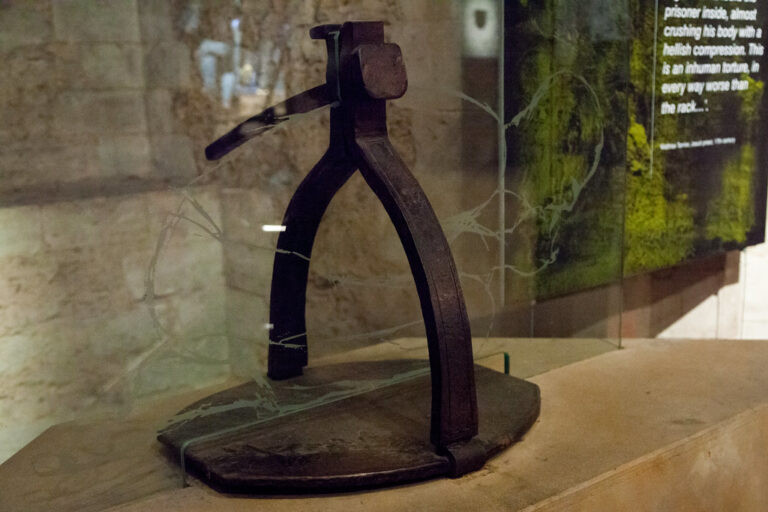The dimly lit dungeons of medieval Europe housed a variety of terrifying torture devices, many of which were designed to extract confessions and punish those accused of crimes. While infamous instruments such as those used during the Spanish Inquisition have become notorious in popular culture, lesser-known but equally sinister devices were employed across other nations. One such obscure contraption was the Scavenger’s Daughter, a brutal invention that originated in England and symbolized the darker aspects of Tudor-era justice.
The Scavenger’s Daughter emerged during the turbulent reign of King Henry VIII, a period marked by political upheaval, religious reform, and the brutal suppression of dissent. The device owes its creation to Leonard Skeffington, the Lieutenant of the Tower of London. Skeffington, a man tasked with overseeing prisoners in the infamous Tower, designed this cruel apparatus as a tool for interrogation and punishment. The name “Scavenger’s Daughter” is, in fact, a corruption of Skeffington’s own surname, ensuring that his legacy would forever be entwined with this grim creation.

Unlike some torture devices that saw frequent use, historical accounts suggest that the Scavenger’s Daughter was rarely employed. However, this rarity did little to diminish its fearsome reputation. The very mention of its name evoked terror, serving as a potent symbol of the lengths to which authorities would go to extract confessions or enforce their will. Its infrequent use may have been due to its extreme nature, which left victims in an agonizing state and often rendered them physically incapable of further resistance.
The mechanics of the Scavenger’s Daughter were as simple as they were horrifying. Unlike the Rack, a more well-known device that inflicted pain by stretching the body, the Scavenger’s Daughter operated on the principle of compression. It consisted of a metal A-frame structure to which victims were strapped. The victim’s head was secured at the apex, their hands bound at the midpoint, and their legs fastened at the base. Once the victim was firmly restrained, the device forced their body into a painfully constricted position. The process drove the knees upward while simultaneously pressing the head downward, creating an unnatural and excruciating posture.
As the body was compressed, immense pressure was exerted on the victim’s muscles and internal organs. This grotesque position often caused blood to ooze from the nose and ears, while severe muscle and tissue damage added to the torment. The agony inflicted by the Scavenger’s Daughter was not just physical but psychological as well. Victims, already weakened by captivity, were subjected to a level of suffering that tested the limits of human endurance.
Despite its simplicity, the Scavenger’s Daughter was a remarkably effective instrument of torture. Its design was straightforward, requiring only three iron planks arranged in an A-shape and a set of straps to secure the victim. Yet this rudimentary structure achieved a level of cruelty that rivaled more elaborate devices of the time. The simplicity of its construction stood in stark contrast to the complex suffering it inflicted, reflecting the grim ingenuity of its creator.
The Scavenger’s Daughter holds a unique place in the annals of history as a chilling reminder of the brutal measures employed in the pursuit of confessions and control. Its very existence speaks volumes about the oppressive nature of justice in Tudor England, where the line between punishment and persecution was often blurred. Those who fell victim to such devices were not only subjected to unimaginable pain but were also stripped of their dignity and humanity.
Today, the Scavenger’s Daughter serves as a sobering symbol of the darker side of human history. As we reflect on its use, we are reminded of the importance of upholding human rights and the progress that has been made in the pursuit of justice. The medieval period was a time when authority was often enforced through fear, and devices like the Scavenger’s Daughter exemplified the lengths to which those in power were willing to go to maintain control.
While the Scavenger’s Daughter is now relegated to the pages of history books and museum exhibits, its story continues to resonate. It stands as a testament to the resilience of the human spirit in the face of oppression and as a stark warning of the dangers of unchecked power. The device may no longer exist in practice, but its legacy endures as a powerful reminder of the need for justice tempered by compassion and respect for human dignity.
The grim tale of the Scavenger’s Daughter also offers a broader lesson about the evolution of societal values. In the centuries since its use, humanity has made significant strides in promoting fairness, equality, and the humane treatment of individuals. The contrast between the brutal practices of the past and the legal standards of today highlights the progress that has been achieved, though it also serves as a reminder of the work that remains to be done.
By examining the history of the Scavenger’s Daughter, we gain valuable insights into the ways in which societies have grappled with issues of justice, power, and human rights. Its story is not merely one of cruelty and suffering but also one of reflection and growth. The device, once a tool of terror, now stands as a symbol of the enduring quest for a more just and compassionate world.
In conclusion, the Scavenger’s Daughter is more than just a relic of medieval torture—it is a stark reminder of the consequences of injustice and the resilience of the human spirit. Its history challenges us to learn from the past and to continue striving for a future where justice is guided by empathy and respect for all. By remembering the lessons of this dark chapter, we honor the countless individuals who suffered and reaffirm our commitment to building a world free from such cruelty.





